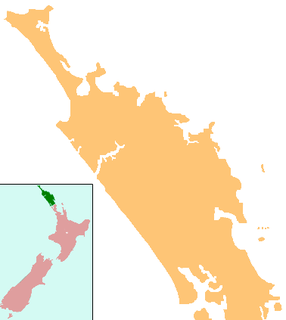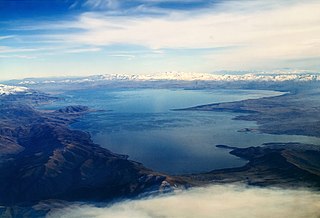
Hamilton is a city in the North Island of New Zealand. It is the seat and most populous city of the Waikato region, with a territorial population of 169,300, the country's fourth most-populous city. Encompassing a land area of about 110 km2 (42 sq mi) on the banks of the Waikato River, Hamilton is part of the wider Hamilton Urban Area, which also encompasses the nearby towns of Ngaruawahia, Te Awamutu and Cambridge.

Matamata is a town in the Waikato Region of New Zealand's North Island. It is located near the base of the Kaimai Ranges, and is a thriving farming area known for Thoroughbred horse breeding and training pursuits. It is part of the Matamata-Piako District, which takes in the surrounding rural areas as well as Morrinsville and Te Aroha. State Highway 27 and the Kinleith Branch railway run through the town. The town has a population of 7,920 as of June 2018.

The Horeke basalts is a disused formation that contained Miocene-Pliocene basalt lava flows that covered a large area in central Northland Region of New Zealand, and in places forms a high plateau around Okaihau.

Te Wairoa is a deserted village located close to the shore of Lake Tarawera in New Zealand's North Island. It was a Māori and European settlement founded in 1848 by the Revd Seymour Mills Spencer where visitors would stay on their way to visit the Pink and White Terraces. The village was destroyed by the eruption of the volcano Mount Tarawera on June 10, 1886. 120 people died in the eruption, many of them in other villages closer to the volcano.The site of one of these villages (Kokotaia) was instrumental in the recent rediscovery of the Pink and White Terrace locations.

The Whanganui River is a major river in the North Island of New Zealand. It is the country's third-longest river, and has special status owing to its importance to the region's Māori people. In March 2017 it became the world's second natural resource to be given its own legal identity, with the rights, duties and liabilities of a legal person. The Whanganui Treaty settlement brought the longest-running litigation in New Zealand history to an end.

Tame Wairere Iti is a Tūhoe Māori activist in New Zealand. He grew up in the Urewera area, and in the late 1960s and 1970s he was involved in protests against the Vietnam War and apartheid in South Africa, and in many Māori protest actions. His ability to court controversy and his full tā moko make him well-recognised.

The Mokau River is located in the North Island of New Zealand.
Waikato Tainui, Waikato or Tainui is a group of Māori people iwi based in Waikato Region, in the western central region of New Zealand's North Island. It is part of the larger Tainui confederation of Polynesian settlers who arrived to New Zealand on the Tainui waka. The tribe is named after the Waikato River, which plays a large part in its history and culture.

Forest Lake is a suburb of Hamilton in New Zealand and was added to from around the 1930s. It is centred around Forest Lake Road, which is used by around 10,000 vehicles a day.

Mount Damper Falls is a waterfall in the North Island of New Zealand on a tributary, Mount Damper Stream, of the Tongapōrutu River.

Horeke is a settlement in the upper reaches of the Hokianga Harbour in Northland, New Zealand. Kohukohu is just across the harbour. The Horeke basalts are located near the town, and can be viewed on an easy stroll through the Wairere Boulders, a commercial park.

The Karikari Peninsula on the east coast of the far north of Northland is between Rangaunu Harbour to the west, and Doubtless Bay to the southeast. It is a right-angled land mass of two relatively distinct parts. The rocky northern part, which has an east–west orientation and is approximately 17 km long, was originally an island but is now connected to the mainland by a low sandy tombolo approximately 11 km long, which has a north–south orientation. The spiritually significant Puwheke sits high above the north-facing beaches.

Wairere Falls, the highest waterfall in New Zealand's North Island, plunges 153 metres (500 feet) in two steps over the Kaimai escarpment.
The Wairere River or Wairere Stream is a river of the Northland Region of New Zealand's North Island. It flows northwest to reach the Waihou River, an arm of the Hokianga Harbour.
The Waikato and King Country regions of New Zealand are built upon a basement of greywacke rocks, which form many of the hills. Much of the land to the west of the Waikato River and in the King Country to the south has been covered by limestone and sandstone, forming bluffs and a karst landscape. The volcanic cones of Karioi and Pirongia dominate the landscape near Raglan and Kawhia Harbours. To the east, the land has been covered with ignimbrite deposits from the Taupo Volcanic Zone. Large amounts of pumice from the Taupo Volcanic Zone have been deposited in the Waikato Basin and Hauraki Plains.

Pukete Bridge is a concrete box girder bridge in Hamilton, New Zealand, spanning the Waikato River.
Wairere Boulders is a private nature reserve with geologically rare rock formations, at Wairere, in the Hokianga region of northern New Zealand. The Wairere Boulders is a popular tourist attraction in the area. Visitors can walk around the various trails, kayak down the boulder river and stay at the campsite. The property is owned by Graham and Paula Grant, who are originally from Scotland. They took over the property in 2017 and have sustainably developed the nature reserve, by extending and upgrading the trails, creating a campground, and opening a cafe. The farm is now a beef breeding enterprise, with Highland Cattle.

Whakaawi was a Māori woman of high birth in both the Ngāti Te Wehi tribe and Ngāti Mahuta tribe, who was the senior wife of the chief Pōtatau Te Wherowhero, who died in 1860. His other wives were Waiata, Raharaha and Ngawaero.
Gordonton is a village and rural community in Waikato District and Waikato Region of New Zealand's North Island. It is located southeast of Taupiri on State Highway 1B.
















